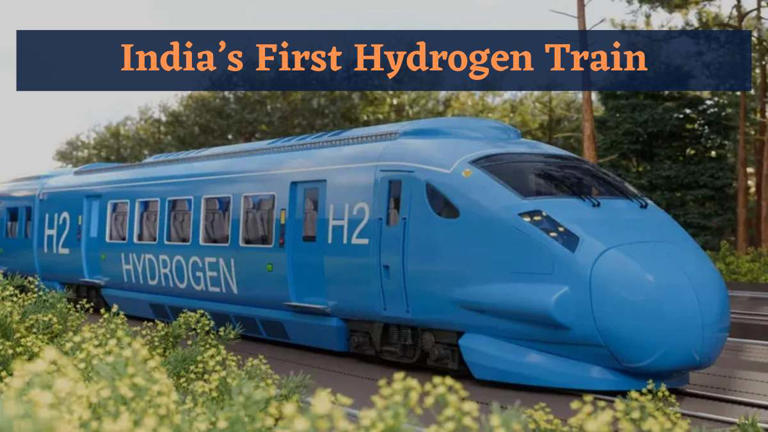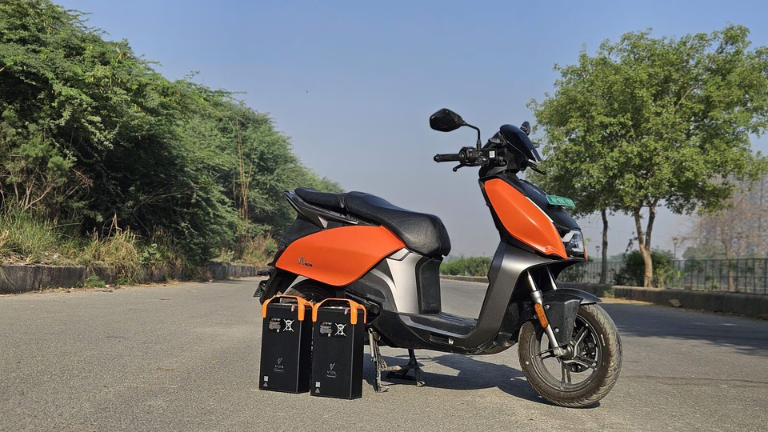India’s First Hydrogen Train Set to Launch Soon: A Major Leap Toward Green Railways
India’s first hydrogen train is set to revolutionize the country’s railway system, marking a historic step toward sustainable and eco-friendly transportation. Scheduled to begin operations on the Jind-Sonipat route in Haryana by March 31, 2025, this initiative aligns with India’s commitment to reducing carbon emissions, promoting clean energy, and modernizing its railway network.
Hydrogen-powered trains represent the future of green transportation, as they operate using hydrogen fuel cells, producing only water and heat as byproducts. This makes them significantly cleaner than diesel trains, reducing both air pollution and noise levels.
India’s First Hydrogen Train: Key Features
The launch of India’s first hydrogen train introduces cutting-edge railway technology that blends efficiency, sustainability, and modern design.
🚆 Top Features of India’s First Hydrogen Train:
✅ Maximum Speed: Capable of reaching 110 km/h, ensuring efficient passenger transport.
✅ Passenger Capacity: Can accommodate 2,638 passengers, making it ideal for high-density commuter routes.
✅ Engine Power: Equipped with a 1,200-horsepower engine, making it the world’s most powerful hydrogen-powered train.
These advanced features will enhance passenger comfort, improve efficiency, and position India as a leader in green railway technology.
India’s First Hydrogen Train Route: Why Haryana?
The Jind-Sonipat route in Haryana has been chosen as the launch corridor for India’s first hydrogen train. This decision was made based on multiple factors:
📍 Why Haryana?
✅ Strong Railway Infrastructure: Haryana has a well-connected railway network, making it a suitable region for testing and implementation.
✅ Growing Demand for Green Transport: The state is expanding its focus on sustainable transportation, aligning with India’s net-zero carbon goals.
✅ Commuter-Friendly Route: The Jind-Sonipat corridor serves thousands of daily passengers, providing a perfect test environment for hydrogen-powered transport.
If successful, this project could lead to hydrogen train expansion across multiple states in the near future.
Key Benefits of India’s First Hydrogen Train
The introduction of hydrogen fuel cell technology in India’s railway system offers long-term environmental and economic benefits.
🌱 Why India’s First Hydrogen Train is a Game-Changer:
✅ Zero Carbon Emissions: Unlike diesel trains, hydrogen trains produce only water vapor, eliminating harmful greenhouse gases.
✅ Energy Efficiency: Hydrogen fuel cells are more efficient than conventional fossil fuels, making them a cost-effective and sustainable alternative.
✅ Reduced Noise Pollution: India’s first hydrogen train will operate much quieter than traditional locomotives, enhancing passenger experience.
✅ Long-Term Cost Savings: While the initial investment in hydrogen trains is high, they offer lower operational costs over time due to fuel efficiency and reduced maintenance.
India’s adoption of hydrogen-powered railways is a forward-thinking approach to clean energy and public transport modernization.
Indian Railways’ Goal of Achieving Net-Zero Carbon Emissions
The Indian government, under Prime Minister Narendra Modi, has been actively promoting sustainable and energy-efficient transportation. The “Hydrogen for Railways” initiative plays a crucial role in Indian Railways’ mission to become 100% carbon-free by 2030.
📢 India’s Railway Sustainability Goals:
🔹 Full electrification of railway routes to reduce dependency on fossil fuels.
🔹 Investment in alternative fuel technologies, including hydrogen and solar-powered trains.
🔹 Reduction of railway carbon emissions by adopting energy-efficient locomotives and green infrastructure.
Global Inspiration: India Follows the Hydrogen Rail Model of Other Nations
With the introduction of India’s first hydrogen train, the country joins a growing list of nations that have successfully deployed hydrogen-powered trains. Countries like Germany, China, and the UK have already adopted hydrogen technology, demonstrating its efficiency and sustainability.
🚄 Global Hydrogen Train Leaders:
🇩🇪 Germany: Operates Alstom’s Coradia iLint, the world’s first fully operational hydrogen train.
🇨🇳 China: Launched Asia’s first hydrogen-powered train, reaching speeds of 160 km/h.
🇬🇧 United Kingdom: Introduced HydroFLEX, a hydrogen-powered train designed to cut emissions across Britain’s rail network.
By implementing hydrogen rail technology, India aims to revolutionize passenger transport while contributing to global climate action efforts.
What This Means for India’s Future in Green Transportation
The launch of India’s first hydrogen train is a monumental step toward transforming the country’s public transport system.
🔹 Key Takeaways from India’s Hydrogen Train Initiative:
✅ A sustainable alternative to diesel-powered trains, aligning with India’s green energy goals.
✅ Enhanced passenger experience with quieter, cleaner, and more efficient travel.
✅ Boost to India’s global standing as a leader in green railway technology.
✅ Potential for hydrogen train expansion across other railway routes nationwide.
As India takes a bold step toward decarbonizing its railway network, the successful rollout of hydrogen trains will pave the way for further advancements in green transportation technologies.
Final Thoughts: A Transformative Moment for Indian Railways
India’s first hydrogen train is more than just an innovation in railway technology—it represents India’s larger commitment to sustainability, clean energy, and modern public transport.
🚀 Key Highlights:
✅ Launch Date: March 31, 2025
✅ First Route: Jind-Sonipat (Haryana)
✅ Technology: Hydrogen Fuel Cell-Based Locomotive
✅ Environmental Benefits: Zero Carbon Emissions, Noise Reduction, and Energy Efficiency
✅ Global Impact: Aligning with international green transport initiatives
With Indian Railways aiming for a net-zero carbon footprint by 2030, the introduction of India’s first hydrogen train is a crucial step toward achieving that vision.💬 What do you think about India’s hydrogen train initiative? Do you believe it will transform the country’s railway system? Share your thoughts in the comments below! ⬇️🚆🌿







